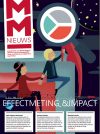Een van de sprekers tijdens de Cultuur 2.0 conferentie was Christopher Sandberg. Sandberg is directeur en oprichter van P, een bedrijf dat zich, in samenwerking met onder meer het Zweeds Instituut voor Computerwetenschap, concentreert op het ontwikkelen en produceren van participatory, player driven and pervasive entertainment in the virtual and real public spaces. Sandberg deed eerder onderzoek op het gebied van games bij het Interactive Institute en was oprichter van Scandinavis eerste cross media DTV-kanaal. Ook was hij de producent van Scandinavis eerste reality game en van enkele reality tv-series bij de Zweedse publieke omroep SVT. In dit artikel licht hij toe vanuit welke filosofie P werkt en gaat hij tevens in op enkele trends in het 2.0 tijdperk.
The two point o movement from information technology to social medias is not primarily a technological advancement. Transformation of the internet, from a more static expository channel, to a radically different social arena, is the fundamental part of 2.0, where the real change lies in the approach to human interaction. In other words, the point is that there are two or more participants.
This change, towards a collective of design and production (as well as distribution, testing and development), is both a reaction to cultural changes in the society at large, and a catalyst in accelerating this change. When the needs for collaborative work grew, the technological development steered away from proprietary software, towards collective open source developments and when these tools for collaboration emerged, more collaboration was facilitated.
Collective endeavours, networked distribution and peer to peer reviews, dramatically changes how the content of the internet spreads (as piracy or shareware). It also changes the function of the internet itself. Our online computers are no-longer just vehicles for prefabricated content in fact content is an outdated word. In the 2.0 paradigm, we share social and creative processes via the computer. What is in there (the content) is less important, than what we do with it together (the shared creations). This is why we see so much poor content on the internet; the participants put value on the who and why, not the what. Who communicates this with me, and why does he do it. In other words, the participants value the meaning the content has for the community, not the quality.
To exemplify: the value of the big brands of the 2.0 age, such as YouTube and Flickr, is measured in the social functions they provide. They enable the participants to store, view and share content (audiovisual and visual, in these two examples). Nobody cares about the production quality of these films and photographs, instead it is the meaning they hold for the creator, or for the one who recommended it, or for you, that is important. Do they make you laugh? Are they memories of precious moments?
As I mentioned, when these tools for collective creation and dissemination became readily available, the changes accelerated. The technology speeds up the emergence of a participatory society. This change is not only in digital expressions, but instead the physical and the virtual mingle, and sometimes switch places. The fictitious and the real do too. This means we live in an age where value comes not from the physical substance or truth of the artefact, but from its function within a chosen lifestyle. The fantasy as determining as the mundane, the virtual space as absolute as the concrete streets.
The manifestations of this age are truly astonishing. And again, these realisations of the participatory culture are not confined to the mere technical and digital. As an example I would like to finish with the collective live action role-play project Dragonbane. For three years we organisers and participants envisioned a fantasy village based on the book The age of the Storm, by Mike Pohjola. Step by step this idea grew from dream, to sketch, to digital model, to miniature and then to the real. The villagers from 18 countries all over Europe and the rest of the world met and lived over the years, in the chat rooms and forums, in their homes in Rome or Tampere and finally in the forest, building the real town together in the dark forests of northern Sweden. For us the fantasy became reality, and a reality filled with the magic we gave birth to.
Auteur: Christopher Sandberg christopher.sandberg@thecompanyp.com www.thecompanyp.com
